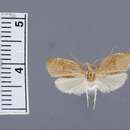Comprehensive Description
(
الإنجليزية
)
المقدمة من Smithsonian Contributions to Zoology
Gonionota cologramma
Alar expanse 20 mm.
Labial palpus tawny; second segment with a faint rosy hue and with a few blackish scales apically; third segment with blackish scales toward apex; apex ocherous white. Antenna reddish basally, shading to light brown toward apex and faintly annulated gray; scape reddish dorsally, ocherous white ventrally. Head mixed gray, tawny, and reddish. Thorax tawny with gray dorsal spot posteriorly; tegula tipped ocherous white. Forewing ground color tawny, outer half crossed by numerous, irregular, fine pale lines; costa narrowly gray mixed with some pink scales; at apical fifth of costa a gray spot; at basal third, in cell, two blackish discal spots, one larger than the other; at end of cell a white spot; around termen a series of short blackish dashes; on fold, about middle a dark brown spot; dorsum with a conspicuous brown stripe; costal area, and from fold to the brown dorsal streak, suffused rosy-pink; cilia tawny. Hindwing buff, somewhat darker toward anal angle. Foreleg ocherous with scattered tawny and pink scales; midleg similar; hindleg ocherous white. Abdomen ocherous white, suffused tawny dorsally.
Male genitalia slide JFGC 12058. Harpe of about equal width to beyond middle, then gently narrowed to a truncate cucullus; sacculus broadly sclerotized, recurved beyond middle. Gnathos a long, narrow, transverse roll. Uncus broad basally, constricted at middle, terminating in two divergent arms. Socii two setose papillae. Vinculum a narrow band. Tegumen about as broad as long, constricted at middle. Anellus a subrectangular plate with a slender pointed process posteriorly at each corner. Aedeagus stout, curved, apex linguiform; vesica armed with a cluster of short, stout cornuti.
HOLOTYPE.—USNM 71085.
TYPE LOCALITY.—Venezuela, Aragua, Rancho Grande, 1100 m.
DISTRIBUTION.—Venezuela.
Described from the unique holotype (10–21. II. 69, W. D. Duckworth and R. Dietz).
Superficially cologramma is much like G. hydrogramma (Meyrick), exhibiting the same type of pale transverse strigulae found in that species, but the pale hindwing of cologramma immediately distinguishes it from the latter. In male genitalia the two are strikingly similar, the chief difference being the length of the basal bar of the clasper which extends beyond middle of harpe in hydrogramma and terminates at or before middle of harpe in cologramma. The cornuti are more numerous in cologramma than in hydrogramma but must be compared (see Figure 5 and Clarke 1963: pl. 114: fig. 4a).
G. hydrogramma, anisodes, cologramma, aethographa and aethoptera constitute a group of similarly colored species all having in common a dark dorsal stripe on the forewing.
- الاقتباس الببليوغرافي
- Clarke, J. F. Gates. 1971. "Neotropical Microlepidoptera XIX: notes on and new species of Oecophoridae (Lepidoptera)." Smithsonian Contributions to Zoology. 1-39. https://doi.org/10.5479/si.00810282.95
Gonionota cologramma: Brief Summary
(
الإنجليزية
)
المقدمة من wikipedia EN
Gonionota cologramma is a moth in the family Depressariidae. It was described by John Frederick Gates Clarke in 1971. It is found in Venezuela.
The wingspan is about 20 mm. The forewings are tawny, the outer half crossed by numerous, irregular, fine pale lines. The costa is narrowly grey mixed with some pink scales and at the apical fifth of the costa is a grey spot. There are two blackish discal spots at the basal third, in the cell, one larger than the other and at the end of the cell is a white spot. Around the termen is a series of short blackish dashes and there is a dark brown spot on the fold, about the middle. The dorsum has a conspicuous brown stripe. The costal area, and from the fold to the brown dorsal streak, is suffused rosy pink. The hindwings are buff, somewhat darker toward the anal angle.

